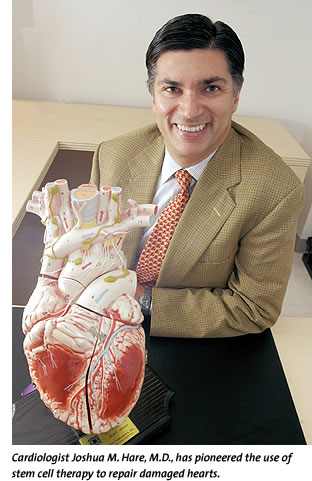Joshua M. Hare,
M.D., brings labs and research to Miami
New Cardiology Chief Pioneers Research in Repairing Hearts
 hen
Joshua M. Hare, M.D., arrives in Miami in January, the Miller School
of Medicine campus is going to feel a lot like home to him. That’s
because the vast majority of his lab team from The Johns Hopkins University
will also be here.
hen
Joshua M. Hare, M.D., arrives in Miami in January, the Miller School
of Medicine campus is going to feel a lot like home to him. That’s
because the vast majority of his lab team from The Johns Hopkins University
will also be here.
 Hare, professor of medicine and biomedical engineering,
has joined the Miller School as chief of the Division of Cardiology and
director of the
new Interdisciplinary Stem Cell Institute. Joining him in Miami will
be up to 10 postdoctoral fellows, technicians, and graduate students
from
Hare’s lab at Johns Hopkins.
Hare, professor of medicine and biomedical engineering,
has joined the Miller School as chief of the Division of Cardiology and
director of the
new Interdisciplinary Stem Cell Institute. Joining him in Miami will
be up to 10 postdoctoral fellows, technicians, and graduate students
from
Hare’s lab at Johns Hopkins.
“I am very excited by the energy and attitude toward developing additional programs at the University of Miami,” Hare says. “The president and the dean have a very forward-thinking approach to academic medicine, one in which I think academics will flourish.”
![]() Hare’s lab at Hopkins has been pioneering the use of stem cell therapy
to repair damaged hearts. At the Miller School, Hare hopes to “make
stem cell therapy for hearts a linear process—from the bench to the
bedside and, importantly, back to the bench again. We are ideally poised
to do clinical trials and to move the scientific field forward.”
Hare’s lab at Hopkins has been pioneering the use of stem cell therapy
to repair damaged hearts. At the Miller School, Hare hopes to “make
stem cell therapy for hearts a linear process—from the bench to the
bedside and, importantly, back to the bench again. We are ideally poised
to do clinical trials and to move the scientific field forward.”
“Josh Hare is an outstanding cardiologist who directs the heart failure programs at Johns Hopkins, a premier heart center in the United States. Hare, the thought leader in our field, rejects the idea that we are doing enough for our patients with injured hearts,” says Pascal J. Goldschmidt, M.D., senior vice president for medical affairs and dean of the Miller School of Medicine. “The need is for novel interventions that aim at reconstituting normal cardiac tissue where the heart has been destroyed.”
The use of cell therapy to repair the damaged heart provides patients afflicted with the nation’s most common disorder “an opportunity that is unmatched, barely explored, and incredibly promising,” says Goldschmidt.
Hare views building the stem cell institute as “an opportunity that will enable existing programs to work together synergistically. Part of my enthusiasm for coming is that we’ll be able to do everything right from the beginning. We really have a building opportunity here, and we will build a world-class program with the support of the administration and the University’s Board of Trustees.”
The individuals in Hare’s soon-to-be-transplanted laboratory are equally as eager to build the newly formed stem cell institute. “A year from now, our program will be firing on all cylinders and will have introduced many new research technologies to aid our work,” Hare vows.